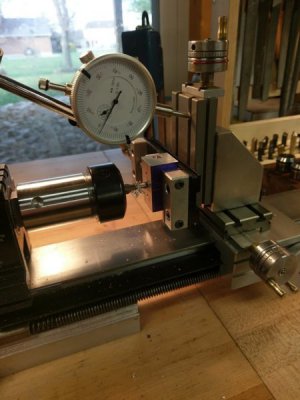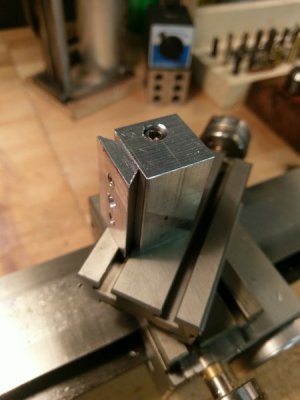- Joined
- Mar 7, 2017
- Messages
- 8
Hello all,
First post here and I'm and absolute beginner so, any and all advice is greatly appreciated!
I bought a Taig Mini-lathe about 2 years ago and I've been slowly learning to use it. Its a ton of fun, absolutely love the machine. I recently, in a desire for a bit more precision, got an ER-32 collet chuck for. Its totally changed my world. So much stronger and accurate than the 3 and 4 jaw chucks.
I also happened across a garage/estate sale from the family of an old union machinist. I bought his tooling for next to nothing. I realized that I can't use most of the lathe bits as I don't have any height adjustment on my stock toolpost. I found a youtuber who recently made a QCTP for a Taig specifically and had the plans available. With a set of plans, a good collet chuck, and a ton of end mills I figured, why not give it a try.
So, I'm working with 6061 Aluminum, 1" square stock. I'm using the Taig milling attachment for the lathe, and the small milling vise. I've been able to face off the square stock with no issue, but theres a few pieces that need some support with parallels. I just can't for the life of me get the parts clamped up squarely. -- I also have zero experience in any milling operation, its been more trial and error learning.
I don't have a set of parallels. Do they make any in micro-lathe-milling size?
The plans themselves use a bolt on style of dovetail, as it was designed for someone without a dovetail cutter. but I just can't seem to square it up.
This is my setup, which seems to work fine for parts that are large enough. (pay no attention to my very poorly placed indicator )
)

And this is the part with the bolt on dovetail.

Any thoughts at all would be greatly appreciated! Thanks!
~Casey
First post here and I'm and absolute beginner so, any and all advice is greatly appreciated!
I bought a Taig Mini-lathe about 2 years ago and I've been slowly learning to use it. Its a ton of fun, absolutely love the machine. I recently, in a desire for a bit more precision, got an ER-32 collet chuck for. Its totally changed my world. So much stronger and accurate than the 3 and 4 jaw chucks.
I also happened across a garage/estate sale from the family of an old union machinist. I bought his tooling for next to nothing. I realized that I can't use most of the lathe bits as I don't have any height adjustment on my stock toolpost. I found a youtuber who recently made a QCTP for a Taig specifically and had the plans available. With a set of plans, a good collet chuck, and a ton of end mills I figured, why not give it a try.
So, I'm working with 6061 Aluminum, 1" square stock. I'm using the Taig milling attachment for the lathe, and the small milling vise. I've been able to face off the square stock with no issue, but theres a few pieces that need some support with parallels. I just can't for the life of me get the parts clamped up squarely. -- I also have zero experience in any milling operation, its been more trial and error learning.
I don't have a set of parallels. Do they make any in micro-lathe-milling size?
The plans themselves use a bolt on style of dovetail, as it was designed for someone without a dovetail cutter. but I just can't seem to square it up.
This is my setup, which seems to work fine for parts that are large enough. (pay no attention to my very poorly placed indicator

And this is the part with the bolt on dovetail.

Any thoughts at all would be greatly appreciated! Thanks!
~Casey
